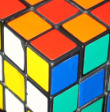 Freshman Stefan Pedrazza takes on the challenging world of Rubik's Cubes
Freshman Stefan Pedrazza takes on the challenging world of Rubik's Cubes
Check back Tuesday for a video of freshman Stefan Pedrazza solving a Rubik's Cube.
We've all seen those multicolored puzzles around. Some of us prefer to scramble those suckers and leave them aside, and hope one day to solve one without having our brain ooze out of our rears. Others peel off the stickers and put them where they should be. But for some, 20 seconds is all they need.
 Freshman Stefan Pedrazza attended his first competition, the Stanford Spring 2010 Rubik's Cube Competition on May 23 at Stanford University. Fingers flying, he ended up solving a 3 by 3 Rubik's Cube in 20.16 seconds and a 2 by 2 in about five seconds. In addition, he solved a 3 by 3 cube one-handed in 1:00:07.
Freshman Stefan Pedrazza attended his first competition, the Stanford Spring 2010 Rubik's Cube Competition on May 23 at Stanford University. Fingers flying, he ended up solving a 3 by 3 Rubik's Cube in 20.16 seconds and a 2 by 2 in about five seconds. In addition, he solved a 3 by 3 cube one-handed in 1:00:07.
Although he didn't place in the competition, being a "cuber" means much more to Pedrazza. As the founder of the Rubik's Cube club at MVHS, cubing is a way for him to meet new people.
"I wanted more people to enjoy [solving Rubik's Cubes] because it's fun, and I wanted to learn from other people," Pedrazza said. "We started late this year, but next year we're going to be more active."
In the three to four months Pedrazza has been actively cubing, he's learned around 100 algorithms to help him solve Rubik's Cubes faster. In addition, he can make checkerboard patterns and flower patterns on the cubes.
"He [has] probably the fastest improvement I've ever seen," club adviser Joe Kim said. "He's [already solved a cube in less than] 20 [seconds], it's amazing."
Anyone who has tried solving a Rubik's Cube knows it is hard. But Pedrazza's love for the challenge shines through. Of course he has had help from veterans like sophomore Neil Fernandes and senior Steven Yang, of which the latter can solve a 3 by 3 in 12 seconds.
"His growth has been amazing," Fernandes said. "Over the past few months he has not only learned how to solve the cube, but get times that are phenomenal for a beginner."
Kim attributes this vast improvement to Pedrazza's natural talent.
"Your brain has to be very quick-triggered from one step to the next," Kim said. "[Pedrazza] has very good, natural hand-eye coordination and it helps him."
In the meantime, Pedrazza's keeping himself busy learning how to solve a 5 by 5. Come Stanford Spring 2011, and he'll be solving cubes in under ten seconds.
The Rubik's Cube club meets every Thursday at lunch in Mr. Kim's room, C202.
{cc-by-nc-sa}








